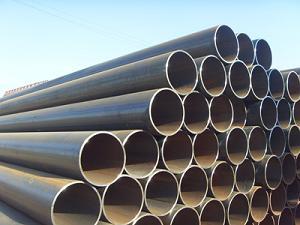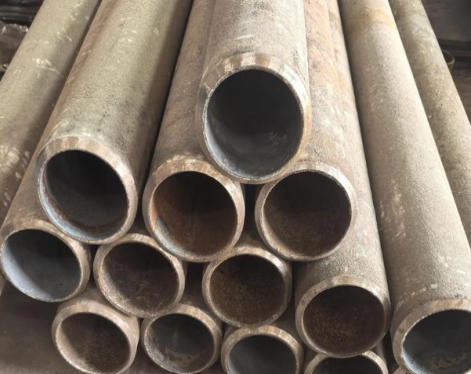The quenching of steel pipes (such as seamless pipes, welded steel tubes) is to heat the steel pipe to the phase transition temperature Ac3 or above Ac1, keep it warm for a period of time, and then rapidly cool it in water, nitrate, oil, or air. The purpose is to obtain a martensitic structure with high hardness. Sometimes when some high-alloy steels (such as stainless steel and wear-resistant steel) are quenched, it is to obtain a single uniform austenite structure to improve wear resistance and corrosion resistance.
The quenching method:
1. Single medium quenching
The steel pipe is cooled in a medium, such as water quenching and oil quenching. The advantages are simple operation, easy mechanization and wide application. The disadvantage is that the quenching stress in water is large, and the steel pipe is easily deformed and cracked. Quenching in oil, the cooling rate is small, the hardening diameter is small, and the large-size steel pipe is not easy to harden.
2. Dual medium quenching
The steel pipe is first cooled to about 300°C in a medium with a stronger cooling capacity, and then cooled in a medium with a weaker cooling capacity. For example, water quenching followed by oil quenching can effectively reduce the internal stress of martensitic transformation, reduce the tendency of steel pipe deformation and cracking, and can be used for quenching steel pipes with complex shapes and uneven cross-sections. The disadvantage of double-liquid quenching is that it is difficult to grasp the moment of double-liquid conversion. If the conversion is too early, it is easy to quench hard, and if the conversion is too late, it is easy to quench and crack. In order to overcome this shortcoming, a graded quenching method has been developed.

3. Grading quenching
The steel pipe is quenched in a low-temperature salt bath or alkali bath furnace. The temperature of the salt bath or alkali bath is near the Ms point. The steel pipe stays at this temperature for 2min~5min, and then takes it out for air cooling. This cooling method is called graded quenching. The purpose of staged cooling is to make the temperature inside and outside of the steel pipe relatively uniform, and at the same time carry out martensitic transformation, which can greatly reduce the quenching stress and prevent deformation and cracking. The classification temperature was previously set at slightly higher than the Ms point, and the steel pipe entered the martensitic zone after the temperature inside and outside was uniform. Improved to grade at temperatures slightly below the Ms point. Practice shows that the effect of grading below the Ms point is better.
4. Austempering
The steel pipe is quenched in an isothermal salt bath, and the temperature of the salt bath is in the lower part of the bainite zone (slightly higher than Ms). Austempering is used for steel pipes with medium carbon and above, the purpose is to obtain lower bainite to improve strength, hardness, toughness and wear resistance. Low carbon steel pipes generally do not use austempering.
5. Surface quenching
Surface quenching is a local quenching method that hardens the surface layer of the steel pipe to a certain depth, while the core part remains unquenched. During surface quenching, through rapid heating, the surface of the steel pipe reaches the quenching temperature quickly, and it is cooled immediately before the heat reaches the center of the steel pipe to achieve partial quenching.
6. Induction hardening
Induction heating is to use electromagnetic induction to generate eddy current in the steel pipe to heat the workpiece.
The quenching method:
1. Single medium quenching
The steel pipe is cooled in a medium, such as water quenching and oil quenching. The advantages are simple operation, easy mechanization and wide application. The disadvantage is that the quenching stress in water is large, and the steel pipe is easily deformed and cracked. Quenching in oil, the cooling rate is small, the hardening diameter is small, and the large-size steel pipe is not easy to harden.
2. Dual medium quenching
The steel pipe is first cooled to about 300°C in a medium with a stronger cooling capacity, and then cooled in a medium with a weaker cooling capacity. For example, water quenching followed by oil quenching can effectively reduce the internal stress of martensitic transformation, reduce the tendency of steel pipe deformation and cracking, and can be used for quenching steel pipes with complex shapes and uneven cross-sections. The disadvantage of double-liquid quenching is that it is difficult to grasp the moment of double-liquid conversion. If the conversion is too early, it is easy to quench hard, and if the conversion is too late, it is easy to quench and crack. In order to overcome this shortcoming, a graded quenching method has been developed.

3. Grading quenching
The steel pipe is quenched in a low-temperature salt bath or alkali bath furnace. The temperature of the salt bath or alkali bath is near the Ms point. The steel pipe stays at this temperature for 2min~5min, and then takes it out for air cooling. This cooling method is called graded quenching. The purpose of staged cooling is to make the temperature inside and outside of the steel pipe relatively uniform, and at the same time carry out martensitic transformation, which can greatly reduce the quenching stress and prevent deformation and cracking. The classification temperature was previously set at slightly higher than the Ms point, and the steel pipe entered the martensitic zone after the temperature inside and outside was uniform. Improved to grade at temperatures slightly below the Ms point. Practice shows that the effect of grading below the Ms point is better.
4. Austempering
The steel pipe is quenched in an isothermal salt bath, and the temperature of the salt bath is in the lower part of the bainite zone (slightly higher than Ms). Austempering is used for steel pipes with medium carbon and above, the purpose is to obtain lower bainite to improve strength, hardness, toughness and wear resistance. Low carbon steel pipes generally do not use austempering.
5. Surface quenching
Surface quenching is a local quenching method that hardens the surface layer of the steel pipe to a certain depth, while the core part remains unquenched. During surface quenching, through rapid heating, the surface of the steel pipe reaches the quenching temperature quickly, and it is cooled immediately before the heat reaches the center of the steel pipe to achieve partial quenching.
6. Induction hardening
Induction heating is to use electromagnetic induction to generate eddy current in the steel pipe to heat the workpiece.









